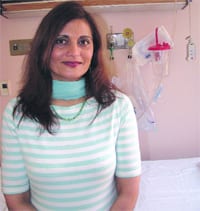Stretching Their Horizons Cancer Patients Complement Their Treatment with Yoga
Radiation. Chemotherapy. Yoga?
When it comes grappling with cancer, the ancient Eastern art of yoga might seem a little out of place among modern, high-tech treatments. But Holyoke Medical Center is one of many health systems that have seen value in complementing mainstream therapies with more holistic practices to promote healing and wellness in cancer patients.
“It’s a positive experience for them,” said Dr. Zubeena Mateen, director of Hematology and Oncology at HMC, regarding a monthly yoga support group for women with cancer.
“There have been several studies conducted with cancer patients showing that yoga improves their mood, sleep quality, and cancer-related stress,” she said. “Sometimes it helps relieve their cancer-related symptoms like pain and fatigue, depression, appetite, and bowel issues, and overall promotes peace and tranquility and helps the overall immune system.
“There hasn’t been too much research on that,” Mateen added, “but that positive attitude, positive self-image is supposed to release endorphins in the brain, helping people feel more happy and peaceful, and helps them to cope with the diagnosis.”
Yoga — derived from a Sanskrit word meaning ‘union’ — is a form of nonaerobic exercise that involves posture, breathing exercises, and meditation.
According to the American Cancer Society “yoga can be a useful method to help relieve some symptoms of chronic diseases such as cancer, arthritis, and heart disease, and can lead to increased relaxation and physical fitness.”
While the ACS stresses that scientific evidence does not support yoga as an effective treatment for cancer or any other disease, but it may enhance quality of life and aid in immune function by promoting general wellness. For that reason, some cancer treatment centers, like HMC, offer yoga programs in addition to standard medical treatment.
According to the society, research has shown that yoga can be used to control physical functions such as blood pressure, heart rate, breathing, metabolism, body temperature, brain waves, and skin resistance, which can result in improved physical fitness, lower levels of stress, and increased feelings of relaxation and well-being.
Flexible Thinking
According to a report to the National Institutes of Health, evidence suggests that yoga may be helpful when used in conjunction with conventional medical treatment to help relieve some of the symptoms linked to cancer, asthma, diabetes, drug addiction, high blood pressure, heart disease, and migraine headaches. Yoga may also also help to reduce cholesterol levels when used with diet and exercise. Randomized clinical trials have shown that yoga can help relieve the pain of arthritis and may also help anxiety, stress, and depression.
One small clinical trial showed that people with lymphoma reported fewer sleep disturbances, fell asleep more quickly, and slept longer after a seven-week yoga program, compared to patients who did not participate in yoga. However, the patients showed no improvement in depression or fatigue.
“There is much more to yoga than just sitting in certain positions and stretching the body,” said Christian Nordqvist, editor of online journal Medical News Today. “Yoga has much more to do with a human’s spiritual and mental well-being than many people realize.”
He cited a study conducted by the M.D. Anderson Cancer Center at the University of Texas that suggested that breast cancer patients who do yoga tend to enjoy better health, less fatigue, and experience less daytime sleepiness — a result that also applies to women who are undergoing radiotherapy for their breast cancer.
Lorenzo Cohen, the study leader, said even a short yoga program — including meditation, relaxation, breathing exercises, stretching, imagery, and physical movements — can be very useful at reducing the side effects that come with breast cancer treatment.
The study looked at 61 women who were undergoing a six-week radiotherapy course after breast cancer surgery. Half of them attended a twice-weekly yoga class, while the other half didn’t. At the end of the courses, they had to fill in a questionnaire asking how they coped with simple tasks such as lifting shopping bags and walking a mile, how tired they felt, and other questions related to their general well-being and ability to carry out physical functions.
The responses were translated into a point system based on how well the women felt, up to a maximum of 100. The yoga group scored an average of 82 points, while the non-yoga group scored 69.
“Yoga combines different aspects of exercise that all cancer patients need: gentle and non-invasive exercise, focused breathing, and meditation,” said Jennifer Weiss, a writer documenting her experience with yoga at associatedcontent.com.
“It has been found that the stretching and poses in yoga can patients with conditioning and will help manage fatigue,” she noted. “Because yoga has specific breathing technique, it can help patients focus their attention and fight off the depressive intrusive thoughts and focus more on relaxing. The breathing helps give patients the ability to focus on something other than the illness.”
Breathing Easier
At Holyoke Medical Center, Mateen said, yoga instructor Patty Weiss (CHECK NAME) goes over different techniques and explains how they relate to rehabilitation …
“Sometimes people have problems with their arms, or lymphedema, and this helps deliver an improved range of motion and then overall well-being,” she said. “Yoga can help lower blood pressure, and for patients with asthma, it tends to help them with their breathing. It has shown to be effective for arthritis, carpal tunnel syndrome, menopausal symptoms, fatigue, and cognitive functions.”
Then there’s the emotional benefit. “It’s a support-group situation with other women who have a similar diagnosis and are in the same situation. This helps them bond with each other and gives them a very positive experience.”
The program has been so successful that the hospital will launch a second group next month for oncology patients and their relatives and caregivers. In both groups, patients are encouraged to go at their own pace, and those with physical limitations are able to adapt — for instance, by sitting in a chair instead of on the floor.
Not only yoga, but Reiki and other forms of complementary therapies are gradually making their way into hospitals everywhere, said Mateen, partly because patients are becoming aware of these practices on their own and are starting to demand them.
“It’s something that doesn’t have any side effects, and it helps patients, so it’s a win-win situation,” she said. “Even if it’s a placebo effect, it doesn’t hurt, it doesn’t have the side effects of a drug, it doesn’t cost that much, and patients feel better. Based upon the public demand, we’re encouraged to do more of these programs.”



Comments are closed.